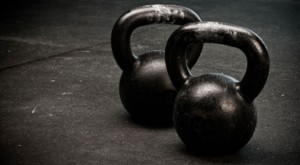Kettlebells are all the rage in fitness these days. But these old school training tools can cause injury if not used properly. We interviewed Sandy Sommer, RKC of Charm City Kettlebells, a 4 year kettlebell expert to get the pros and cons of kettlebells.

What do you need to know about kettlebells?
Sandy: The first think is to remember the dynamic nature of most kettlebell exercises. You’re working in an arc instead of perpendicular to the ground. There’s a huge opportunity for injury if they’re not done well and safely. I really don’t think anybody has any business picking up a kettlebell without instruction or they’re potentially going to injure themselves.
Why the risk of injury?
Sandy:You’re talking about something that is moving on an arc and has momentum behind it. You have to know the appropriate size bell. Too light is going to be as dangerous as too heavy.
What is a typical first session like?
Sandy:We interview someone and make sure that their past doesn’t preclude them for doing kettlebells such as joint impingements or other injuries. You need some prudence and self-awareness and dialing back the testosterone a bit if you will. Form is everything. We don’t train to failure, we leave a little something in the tank. When I read that so and so did 300 swings in a row it leaves me scratching my head because no one should think that’s typical. A session can take an hour with warm ups and stretching but the kettlebell part is about 20 minutes, usually no more.
Why is working with a certifed kettlebell trainer so important?
Sandy: Why certification is so important is that your average personal training certification doesn’t include kettle bell training. You don’t teach spin unless you’re a certified spin instructor but that hold true with kettlebells and that bothers me. My feeling is that it does require a body of knowledge to teach safely. Some of the stuff I’ve seen on You Tube as instructional as horrendous.
How are Kettlebells different from free weights?
Sandy:Kettlebells behave heavier than they actually are because the center of gravity is below the grip, not in line with the grip and you’re moving in an arc instead of perpendicular to the ground.
What’s so great about kettlebells?
Sandy: I move better at 48 then I did when I was 23 and just finished playing college football. I have no pain anywhere and I did have some lumbar pain that I had to live with for quite some time. One of the most beneficial things is how to use the glutes.
I’ve got a six pack just from doing kettlebells. I see better butts, better legs, better abs, better everything. Every exercise we get folks involved with is truly a full body movement pattern.
What’s the best way to move?
Sandy: Done properly all the movement is from anterior (in front of the body) to posterior (behind the body). What we see is a lot of people than end up rotating theri spine along the thoracic area or rounding their back through the lumbar or the cervical part of the spine. The spine should stay neutral.
The eyes should never follow the kettlebell, the neck should be neutral, the whole spine should be neutral. We see a lot of rounding and flexion and that’s wrong.
More Info
Sandy is certified through the Russian Kettlebell Challenge Certification. He recommends buying kettlebells from here. He also recommends working with people who are trained through the International Kettlebell and Fitness Federation.
You should always make sure that your kettlebell trainer is also a certified personal trainer and has a good solid understanding of anatomy before working with them.
What do you think of kettlebell training? Have you tried it? Do you know anyone who was injured from it?